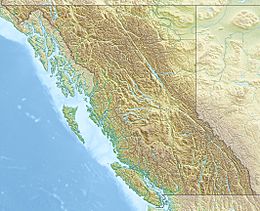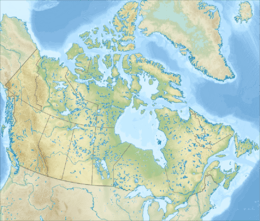Mount Geikie (Canada) facts for kids
Quick facts for kids Mount Geikie |
|
|---|---|

Mount Geikie centered, flanked by Barbican Peak to right, Bastion Peak and Turret Peak to left
|
|
| Highest point | |
| Elevation | 3,298 m (10,820 ft) |
| Prominence | 808 m (2,651 ft) |
| Parent peak | Mount Fraser (3313 m) |
| Geography | |
| Location | Mount Robson Provincial Park British Columbia, Canada |
| Parent range | Canadian Rockies |
| Topo map | NTS 83D/09 |
| Geology | |
| Age of rock | Cambrian |
| Type of rock | Quartzite |
| Climbing | |
| First ascent | 1924 by V.A. Fynn, M.D. Geddes, C.G. Wates |
Mount Geikie, which sounds like "geeky", is a tall mountain peak in Mount Robson Provincial Park in British Columbia, Canada. It stands about 3,298 meters (10,820 feet) high. This amazing mountain is located about 28 kilometers (17 miles) southwest of Jasper.
Mount Geikie is the highest point in a mountain range called The Ramparts. These mountains are part of the Canadian Rockies, which are known for their incredible beauty. The closest taller mountain is Mount Fraser, which is about 8 kilometers (5 miles) away. Also, the Continental Divide is just 3 kilometers (1.9 miles) to the east.
Mount Geikie is made of a type of rock called quartzite. This rock formed during the Cambrian period, which was a very long time ago. Over time, powerful forces pushed this rock upwards and over younger rocks. The north face of Mount Geikie is a huge vertical wall, more than 1,500 meters (4,900 feet) tall. It's considered one of the most impressive rock faces in the Canadian Rockies.
History of Mount Geikie's Name
Mount Geikie got its name in 1898. J. E. McEvoy of the Geological Survey of Canada named it after a famous Scottish geologist. This geologist was Sir Archibald Geikie (1835–1924). He was in charge of the British Geological Survey from 1882 to 1901.
The mountain was first shown on a map in 1911. This map was made by Arthur O. Wheeler and showed the Mount Robson area. The name "Mount Geikie" was officially approved in 1951. This approval came from the Geographical Names Board of Canada.
Climbing Mount Geikie
The first ascent of Mount Geikie happened in 1924. Val Fynn, M.D. Geddes, and Cyril G. Wates were the first to reach the summit. They climbed using a route on the southwest side of the mountain.
The challenging north face was first climbed much later, in 1967. John Hudson and Royal Robbins were the brave climbers who completed this difficult route. Since then, other climbing routes have been established on the north face. These include the Lowe/Hannibal route and the Hesse-Shilling route. The Honky Tonquin route is another very tough climb.
In August 2017, Tony McLane from Canada made history. He completed the first solo climb of the north face. The most common way to climb Mount Geikie today is the Southeast Face route.
Climate and Weather at Mount Geikie
Mount Geikie is located in a subarctic climate zone. This means it has very cold and snowy winters. The summers are usually mild. Temperatures can drop below -20 °C ( -4 °F). With wind, it can feel even colder, sometimes below -30 °C (-22 °F).
The best time to climb Mount Geikie is in July and August. The weather is usually more favorable then. However, these months are also when mosquitoes are most active. So, climbers need good ways to protect themselves from bugs. The journey to reach the mountain can take several days.
Water from Mount Geikie flows into Geikie Creek and Tonquin Creek. These creeks are important because they are the starting points for the Fraser River.



